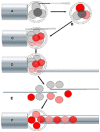Normal bias in the direction of fetal rotation depends on blastomere composition during early cleavage in the mouse
- PMID: 20224769
- PMCID: PMC2835742
- DOI: 10.1371/journal.pone.0009610
Normal bias in the direction of fetal rotation depends on blastomere composition during early cleavage in the mouse
Abstract
Interest in establishing the basis of left/right asymmetry during embryogenesis has burgeoned in recent years. Relevant studies in mammals, focused largely on the mouse, have revealed involvement of a variety of genes that are common to the process in other animals. In the mouse, lateral differences in gene expression are first evident late in gastrulation when directional rotation of nodal cilia has been implicated in effecting the normally very strong bias in handedness. Reconstructing cleavage stages with correspondingly positioned blastomeres from appropriate numbers of conceptuses with similar division planes provides a way of testing whether they differ in potency without the confounding effects of reduced cell number. In a study using this strategy, 4-cell stage conceptuses reconstructed from blastomeres produced by equatorial as opposed to meridional second cleavage were found to be compromised in their ability to support normal development. Here, in more refined reconstructions undertaken at both the 4- and 8-cell stage, no significant impairment of development to the 9(th) or 12(th) day of gestation was found for products of equatorial second cleavage or their 8-cell stage progeny. Most surprisingly, however, a significant increase in reversal of the direction of axial rotation was found specifically among fetuses developing from conceptuses reconstructed from 8-cell stage progeny of products of equatorial second cleavage. Hence, manipulations during early cleavage some 6 days before fetal asymmetries are first evident can perturb the normally very strong bias in specification of a facet of left-right asymmetry.
Conflict of interest statement
Figures



Similar articles
-
Experimental analysis of second cleavage in the mouse.Hum Reprod. 2002 Dec;17(12):3178-89. doi: 10.1093/humrep/17.12.3178. Hum Reprod. 2002. PMID: 12456621
-
The axis of polarity of the mouse blastocyst is specified before blastulation and independently of the zona pellucida.Hum Reprod. 2007 Mar;22(3):798-806. doi: 10.1093/humrep/del424. Epub 2006 Nov 24. Hum Reprod. 2007. PMID: 17127689
-
Unbiased contribution of the first two blastomeres to mouse blastocyst development.Mol Reprod Dev. 2005 Nov;72(3):354-61. doi: 10.1002/mrd.20353. Mol Reprod Dev. 2005. PMID: 16078274
-
Lineage allocation and cell polarity during mouse embryogenesis.Semin Cell Dev Biol. 2004 Oct;15(5):583-97. doi: 10.1016/j.semcdb.2004.04.002. Semin Cell Dev Biol. 2004. PMID: 15271304 Review.
-
Cleavage pattern and emerging asymmetry of the mouse embryo.Nat Rev Mol Cell Biol. 2005 Dec;6(12):919-28. doi: 10.1038/nrm1782. Nat Rev Mol Cell Biol. 2005. PMID: 16341078 Review.
Cited by
-
Somatic mosaicism: implications for disease and transmission genetics.Trends Genet. 2015 Jul;31(7):382-92. doi: 10.1016/j.tig.2015.03.013. Epub 2015 Apr 21. Trends Genet. 2015. PMID: 25910407 Free PMC article. Review.
-
SHROOM3 is a novel candidate for heterotaxy identified by whole exome sequencing.Genome Biol. 2011 Sep 21;12(9):R91. doi: 10.1186/gb-2011-12-9-r91. Genome Biol. 2011. PMID: 21936905 Free PMC article.
-
Early, nonciliary role for microtubule proteins in left-right patterning is conserved across kingdoms.Proc Natl Acad Sci U S A. 2012 Jul 31;109(31):12586-91. doi: 10.1073/pnas.1202659109. Epub 2012 Jul 16. Proc Natl Acad Sci U S A. 2012. PMID: 22802643 Free PMC article.
-
Clonal dynamics in early human embryogenesis inferred from somatic mutation.Nature. 2021 Sep;597(7876):393-397. doi: 10.1038/s41586-021-03786-8. Epub 2021 Aug 25. Nature. 2021. PMID: 34433967
-
Serotonin has early, cilia-independent roles in Xenopus left-right patterning.Dis Model Mech. 2013 Jan;6(1):261-8. doi: 10.1242/dmm.010256. Epub 2012 Aug 16. Dis Model Mech. 2013. PMID: 22899856 Free PMC article.
References
-
- Hirokawa N, Tanaka Y, Okada Y, Takeda S. Nodal flow and the generation of left-right asymmetry. Cell. 2006;125:33–45. - PubMed
-
- Layton WM. Random determination of a developmental process. Hered. 1976;67:336–338. - PubMed
-
- Endo A, Sakai N. The incidence of tail flexion to the left in mouse embryos. Anat Embryol. 1987;176:133–134. - PubMed
-
- Fujinaga M. Rat whole embryo culture system as a tool to investigate developmental mechanisms of left/right body axis. Toxic In Vitro. 1995;9:593–600. - PubMed
Publication types
MeSH terms
LinkOut - more resources
Full Text Sources
Other Literature Sources

